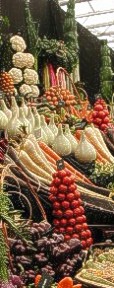From the Ground Up
Stems and Branches
by Derek Burch
We have discussed the general
structure of various parts of the plant. Now we can start looking a little
more closely at what is inside.
At the very tip of a stem, there
is a small group of cells whose function is simply to divide to give more
cells. Each cell produced is just like the one from which it came. Nature
perfected eons ago what we call cloning and have just learned to do in
our test tubes. As each cell of the group divides into two, one daughter
cell is left behind as the other now takes on the job of dividing. As
this one divides, a new daughter cell is left behind, and a new cell takes
on the dividing function. The group of cells doing the dividing is gradually
lifted further from the base of the plant in this way - part of the process
that we call growth in which a stem gets longer. The very tip of the stem
looks exactly the same microscopically in the middle of summer as it did
when growth began for the year in the spring, but, of course, is further
from the base of the plant.
So, nature has perfected the process of producing two identical cells from one,and continuing to do this over and over again. But we know from microscopic studies that the cells in one part of a plant may be quite different from those in another. As cells are left behind by the growing tip, they get bigger (this is the second part of the growth process) and change to become better suited for the various jobs that they have to perform in the plant. Just to give a word for the scrabble addicts, the dividing cells and others that have not been modifed, are said to be totipotent - they have all the genetic instructions in them to be any type of cell in any part of that plant.
The changes that happen in these cells as they mature are caused by chemical signals produced by the plant itself in response to outside factors such as light or wind. The type of cell that each cell turns into is set by the position that it occupies in the stem, so that cells around the outside develop thicker walls and protect the stem, those close to the center turn into the tubes that carry things around the plant, and so on. The process of differentiation is very tightly controlled by the plant as long as it is growing healthily.
Some of the cells left behind as the growing tip is lifted beyond them, will themselves form a group of dividing cells that can give rise to a leaf or to a side shoot. The position of these is very precisely controlled by the plant, with the bud or shoot initial a little above the leaf initial. (If you saw my description of a leaf in the previous issue, you will remember that I said that the leaf always had a bud at the place where it joined the stem, while a leaflet, as part of the leaf, does not.)
These bud and leaf initials have the potential to develop, but do not always do so. In plants that have year round growing conditions in the warm moist parts of the word, most of the leaves do develop. In areas with a seasonal climate, the leaves will mostly develop during periods of growth, but as the season ends, will grow into reduced or scale leaves that cover and protect the bud through the dormant times.
The buds develop according to the instructions contained in the genetic code of the plant. If all develop as they form, the shoot would become a tuft of competing twigs, which would not be particularly useful to the plant. What is more normal is that a limited number of side branches develop, and these are usually spaced well back from the tip. The growing point of the shoot produces a chemical (known as an auxin) that inhibits bud growth, This auxin travels down the stem and as it is diluted during its movement, it loses the power to inhibit and the buds can grow out. Interestingly, this compound continues to travel downwards in the plant, and at the much reduced concentration at which it reaches the roots, it actually stimulates root growth. A synthetic form of this substance is used in most rooting compounds to have this same effect.
From the gardener's point of view, understanding this inhibitory effect of the auxin in the shoot explains how nipping out the tip of a coleus will give us much bushier plants because more of the potential shoots are released from the effect of the auxin. It also explains how arching a long shoot over will cause budbreak along its length: auxins move in the direction of gravitational pull, so if the terminal bud is below the rest of the stem, very little auxin will find its way back to inhibit the buds.
There is much more to the auxin story than this: various other materials with growth regulating activity that work with or against the substance produced by the terminal bud, the ways in which the plant determines fruit growth and maturity, how leaves are dropped in the fall, and almost everything else that goes on in the life of the plant, including far more that we don't understand than that has already been researched.
Fascinating things, plants.
Back to Table of Contents
